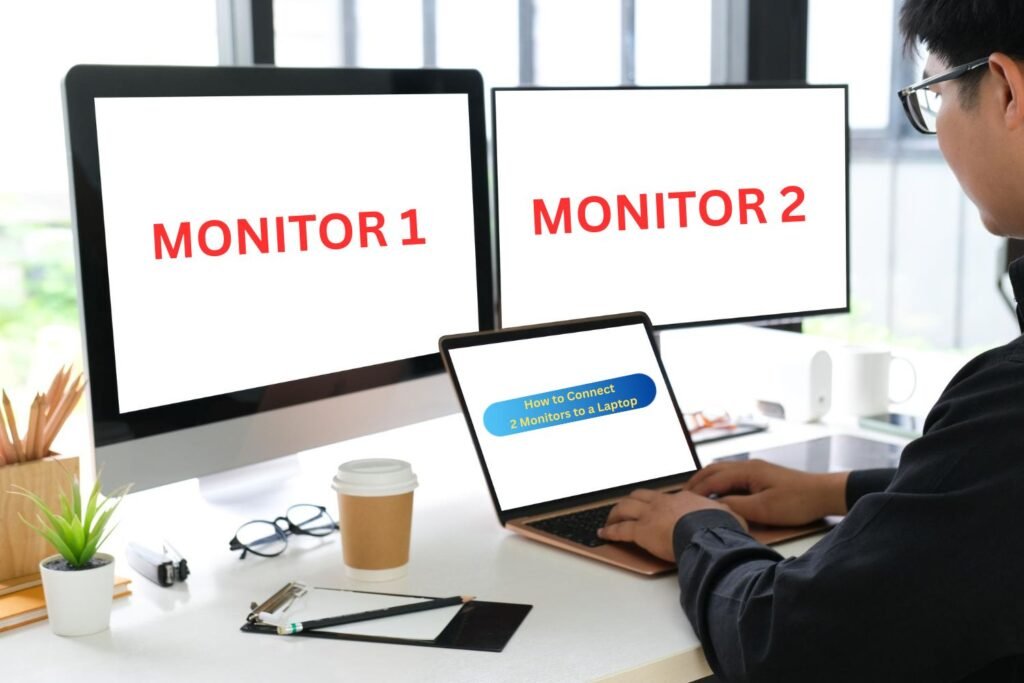Setting up dual monitors can transform your laptop into a productivity powerhouse. Studies show that dual monitor setups increase productivity by up to 42%, making them essential for professionals, students, and remote workers alike. Whether you’re coding, trading, designing, or simply want more screen real estate for multitasking, learning how to connect 2 monitors to a laptop is a game-changing skill.
This comprehensive guide walks you through every aspect of connecting dual monitors to your laptop, from initial compatibility checks to advanced optimization techniques. We’ll cover hardware requirements, step-by-step setup processes, troubleshooting common issues, and brand-specific instructions for popular laptop models, including MacBooks, ThinkPads, Surface devices, and more.
You’ll discover multiple connection methods, understand graphics card limitations, learn Windows and macOS configuration settings, and master professional workflow optimizations. Whether you have a single HDMI port or multiple USB-C connections, we’ll show you exactly how to create your ideal dual monitor laptop setup.
By the end of this guide, you’ll have the knowledge to connect any two monitors to your laptop, optimize performance, and troubleshoot problems like a pro. Let’s transform your workspace and boost your productivity with a properly configured dual monitor setup.
II. Pre-Setup Requirements & Compatibility Analysis
Before diving into your dual monitor setup, checking laptop compatibility is crucial. Your graphics card determines how many external displays you can connect, while available ports dictate connection methods. Most modern laptops support dual monitors through HDMI, DisplayPort, or USB-C connections, but older models may need adapters.
A. Laptop Hardware Assessment
Your laptop’s graphics capability is the foundation of any multi-monitor setup. Integrated graphics like Intel UHD typically support two external displays, while dedicated NVIDIA or AMD cards handle more. Check your graphics card specifications to confirm dual monitor support before purchasing cables or adapters.
B. Laptop Brand-Specific Compatibility Guide
Different laptop brands have unique port configurations and limitations. MacBook users often need USB-C hubs, while ThinkPads excel with docking stations. Surface Pro devices require specific adapters, and Dell XPS laptops vary by model year. Understanding your laptop’s specific requirements prevents compatibility issues.
C. Monitor Selection Criteria
Choosing compatible monitors ensures smooth dual screen operation. Matching resolutions like 1080p or 4K prevents scaling issues, while similar refresh rates avoid display conflicts. Consider your desk space and intended use – coding benefits from vertical monitors, while gaming prefers curved displays.
III. Hardware Requirements & Shopping Guide
Understanding your connection options saves time and money. Single HDMI port laptops need splitters or USB adapters, while USB-C laptops offer more flexibility with hubs and docking stations. Legacy laptops may require DisplayLink technology for dual monitor support.
A. Cable and Adapter Solutions by Scenario
Scenario 1: Single HDMI Port Laptops Most budget laptops have one HDMI port, requiring creative solutions. HDMI splitters duplicate your screen but don’t extend it. For true dual monitor functionality, use a USB-A to HDMI adapter with DisplayLink drivers. This setup works with any laptop and costs under $50.
Scenario 2: USB-C Only Laptops (Modern Ultrabooks) Modern laptops like MacBook Air and Dell XPS rely on USB-C connectivity. USB-C hubs with dual HDMI outputs provide the simplest solution. Ensure your hub supports your laptop’s power delivery requirements and monitor resolutions.
Scenario 3: Multiple Port Configurations Laptops with HDMI plus DisplayPort or multiple USB-C ports offer direct connections. Use high-quality cables to prevent signal degradation. Mix connection types if needed – one monitor via HDMI, another through USB-C works perfectly.
Scenario 4: Legacy Laptop Solutions Older laptops with VGA or DVI ports need adapters for modern monitors. VGA to HDMI converters handle basic setups, while USB graphics adapters provide better performance. Consider whether upgrading your laptop makes more financial sense.
B. Docking Station Comprehensive Comparison
USB-C Docking Stations ($50-$150) Basic USB-C hubs handle dual 1080p monitors effectively. Look for models with power delivery to charge your laptop simultaneously. Popular options include Anker PowerExpand and HP USB-C Dock G5.
Thunderbolt 3/4 Docks ($150-$400) Thunderbolt docks support dual 4K monitors and faster data transfer. They’re essential for MacBook Pro users and high-resolution setups. CalDigit TS3 Plus and Plugable TBT3-UDZ are reliable choices.
Universal DisplayLink Docks ($80-$200) DisplayLink docks work with any laptop through USB-A or USB-C. They’re perfect for incompatible systems but may have slight performance limitations. Dell D6000 and Plugable UD-ULTCDL offer excellent compatibility.
Brand-Specific Docking Solutions ThinkPad users benefit from Lenovo’s mechanical docking stations. Dell WD19TB works seamlessly with Dell laptops. HP’s Thunderbolt Dock G2 integrates perfectly with HP business laptops.
C. Alternative Connection Methods
MST (Multi-Stream Transport) Hubs Explained MST hubs split one DisplayPort signal into multiple outputs. They’re ideal for laptops with single DisplayPort connections. Ensure your graphics card supports MST technology before purchasing.
USB-A to HDMI Adapters (DisplayLink Technology) DisplayLink adapters convert USB signals to video output. They work with virtually any laptop but require driver installation. Performance is suitable for productivity tasks but may struggle with high-refresh gaming.
Wireless Display Solutions (Limitations and Performance) Wireless adapters like Microsoft’s Wireless Display Adapter offer cable-free convenience but introduce latency. They’re suitable for presentations but not ideal for productivity work requiring precise cursor movement.
eGPU Setups for Extreme Multi-Monitor Configurations External graphics cards via Thunderbolt enable desktop-class multi-monitor support. They’re expensive but transform ultrabooks into workstation-class machines supporting multiple 4K displays.
IV. Step-by-Step Setup Process
Proper setup prevents common issues and ensures optimal performance. Following the correct sequence saves troubleshooting time and protects your equipment from potential damage.
A. Physical Connection Phase
Pre-Connection Checklist and Safety Precautions Power down your laptop before connecting monitors. Gather all necessary cables, adapters, and power supplies. Ensure adequate workspace ventilation as dual monitors generate additional heat.
Port Identification with Visual Guides Locate your laptop’s video outputs. HDMI ports are rectangular with beveled corners. USB-C ports are oval-shaped and may support video depending on your laptop model. DisplayPort connections are rectangular with one angled corner.
Cable Management and Workspace Setup Route cables behind your desk to maintain a clean workspace. Use cable clips or ties to prevent tangling. Position monitors at arm’s length with screens at eye level to reduce neck strain.
Power Sequence Optimization Connect monitors to power first, then to your laptop. This sequence ensures proper signal detection. Turn on monitors before booting your laptop for best compatibility.
B. Windows Configuration (Detailed)
Display Detection and Recognition Windows usually detects connected monitors automatically. If not, press Windows + P to open projection settings. Click “Detect” in Display Settings if monitors don’t appear immediately.
Resolution and Scaling Optimization Set each monitor to its native resolution for best image quality. Adjust scaling if text appears too small on high-resolution displays. 125% or 150% scaling works well for most users.
Monitor Arrangement and Orientation Drag monitor icons in Display Settings to match your physical setup. This ensures smooth mouse movement between screens. Set portrait orientation for coding or document work if desired.
Primary Display Designation Your primary display hosts the taskbar and Start menu. Right-click the desired monitor in Display Settings and select “Make this my main display.” Choose your laptop screen or larger external monitor.
Advanced Display Properties Configuration Access advanced settings for color profiles, refresh rates, and HDR options. Match refresh rates between monitors to prevent visual inconsistencies during window movement.
C. macOS Setup Process
System Preferences Display Configuration Open System Preferences > Displays to configure your setup. macOS detects most monitors automatically. Use the “Detect Displays” button if needed.
Arrangement and Mirroring Options Drag display thumbnails to match your physical arrangement. Uncheck “Mirror Displays” to extend your desktop across both screens. The white bar indicates which display houses your menu bar.
Resolution and Scaling for Retina Displays macOS handles Retina scaling automatically. Choose “Scaled” for more resolution options. Higher scaling provides more screen real estate at the expense of text size.
Mission Control Optimization Configure Mission Control to work effectively with dual monitors. Assign different desktop spaces to each monitor for improved workflow organization.
D. Performance Optimization Settings
Graphics Driver Optimization Update graphics drivers regularly for best performance and compatibility. NVIDIA Control Panel and AMD Software provide dual monitor optimization settings.
Power Management Adjustments Adjust power settings to prevent displays from sleeping during presentations. Set longer timeout periods for dual monitor setups to maintain connectivity.
Memory Allocation Considerations Dual monitors increase memory usage, especially at high resolutions. Close unnecessary applications and consider adding RAM if your system struggles.
Thermal Management for Extended Use Monitor your laptop’s temperature during dual screen use. Ensure adequate ventilation and consider a laptop cooling pad for sustained performance.
V. Advanced Configuration & Customization
A. Multi-Monitor Workflow Optimization
Window Management Techniques and Tools Master Windows key shortcuts for efficient window management. Windows + Left/Right snaps windows to screen halves. Third-party tools like DisplayFusion offer advanced window management features.
Taskbar Configuration Across Monitors Windows 10/11 can extend the taskbar across both monitors or keep it on one screen. Right-click the taskbar and choose “Taskbar settings” to configure this behavior.
Wallpaper and Theme Customization Set different wallpapers for each monitor or span a single image across both screens. Windows offers built-in spanning options, while third-party tools provide more creativity.
Keyboard Shortcuts and Hotkey Setup Learn essential shortcuts: Windows + P for projection modes, Windows + Shift + Left/Right to move windows between monitors. Create custom hotkeys for frequently used applications.
B. Application-Specific Configurations
Productivity Software Optimization (Office, Adobe Creative Suite) Configure Microsoft Office to open documents on specific monitors. Adobe Creative Suite benefits from tool palettes on secondary screens while keeping work areas on the primary display.
Development Environment Setup (IDEs, Code Editors) Developers should place code editors on the primary monitor with documentation and terminals on the secondary screen. Configure IDE layouts to span both monitors effectively.
Gaming Considerations (Primary vs Secondary Display Roles) Set games to run on your primary monitor while keeping system monitoring tools, chat applications, or guides on the secondary screen. Ensure consistent refresh rates for smooth gameplay.
Video Editing and Streaming Configurations Use the primary monitor for timeline editing and the secondary for preview, effects panels, or streaming software. Professional workflows benefit from color-calibrated primary displays.
C. Color Calibration and Visual Consistency
Monitor Color Matching Techniques Use Windows Display Color Calibration or macOS Display Calibrator Assistant for basic color matching. Professional work requires hardware calibration tools like X-Rite ColorMunki.
Brightness and Contrast Balancing Match brightness levels between monitors to prevent eye strain. Use the 20-20-20 rule: every 20 minutes, look at something 20 feet away for 20 seconds.
Blue Light Filtering Across Displays Enable Windows Night Light or macOS Night Shift on both monitors. Third-party tools like f.lux offer more granular control over color temperature throughout the day.
Professional Color Accuracy Requirements Graphics professionals need calibrated monitors with wide color gamuts. Consider investing in professional displays if color accuracy is critical to your work.
VI. Comprehensive Troubleshooting Guide
A. Connection and Detection Issues
“Second Monitor Not Detected” Solutions First, check physical connections and power. Force detection through Display Settings. Update graphics drivers and restart your computer. Try different cables or ports to isolate hardware issues.
Intermittent Connection Problems Loose connections cause intermittent display loss. Check cable quality and connector fit. USB-C connections may require specific cable orientations. Replace suspect cables with high-quality alternatives.
Resolution and Scaling Conflicts Mismatched resolutions cause scaling problems. Set both monitors to recommended resolutions. Adjust scaling percentages individually if text appears too large or small on either display.
Audio Routing to Correct Display Windows may route audio to monitor speakers instead of your preferred output. Right-click the volume icon and select “Open Sound settings” to choose your desired audio device.
B. Performance and Stability Problems
Frame Rate Drops and Lag Issues Dual monitors increase graphics processing demands. Lower refresh rates or resolutions if performance suffers. Close unnecessary applications consuming graphics resources.
System Crashes and Freezing Outdated graphics drivers cause system instability. Update drivers from manufacturer websites rather than Windows Update. Check for overheating issues during extended dual monitor use.
Overheating and Thermal Throttling Dual monitors generate additional heat and increase CPU/GPU load. Ensure proper ventilation, clean dust from vents, and consider external cooling solutions for sustained use.
Power Supply Inadequacy Symptoms Insufficient power causes display flickering or system instability. Use powered USB hubs for multiple devices. Consider higher-wattage chargers for laptops struggling with dual monitor setups.
C. Advanced Diagnostic Tools and Techniques
Device Manager Troubleshooting Use Device Manager to identify driver conflicts or hardware issues. Uninstall and reinstall display adapters if problems persist. Check for Windows hardware error codes.
Graphics Driver Debugging Access NVIDIA Control Panel or AMD Software for detailed graphics settings. Reset to default configurations if custom settings cause problems. Use clean driver installation tools when necessary.
Hardware Compatibility Testing Test monitors individually to isolate faulty hardware. Try different connection methods to identify compatibility issues. Use different computers to test monitor and cable functionality.
Performance Monitoring and Optimization Use Task Manager or third-party tools to monitor system performance during dual monitor use. Identify resource-intensive applications and optimize accordingly.
VII. Use Case Scenarios & Optimization
A. Professional Workflows
Financial Trading Setups (Multiple Data Streams) Traders benefit from multiple monitors displaying different market data. Configure primary screens for active trading platforms and secondary displays for news feeds, charts, and research tools.
Software Development (Code + Documentation + Testing) Developers should place code editors centrally with documentation browsers and terminal windows on side monitors. Configure IDE layouts to maximize screen real estate while maintaining comfortable viewing angles.
Graphic Design and Video Editing Creative professionals need color-accurate primary displays for design work with tool palettes and asset libraries on secondary screens. Calibrate monitors regularly for consistent color reproduction.
Data Analysis and Research Workflows Researchers benefit from spreadsheets on primary monitors with reference materials, web browsers, or statistical software on secondary displays. Organize workflow to minimize window switching.
B. Gaming and Entertainment
Gaming + Streaming Dual Monitor Setup Stream on secondary monitors while gaming on primary displays. Configure streaming software to capture specific monitors without affecting game performance. Use dedicated streaming PCs for professional setups.
Media Consumption Optimization Watch videos on one monitor while browsing or working on another. Configure media players for fullscreen on specific displays. Use picture-in-picture modes for multitasking scenarios.
Social Media Management Configurations Social media managers benefit from multiple platform dashboards across different monitors. Organize content creation tools on primary screens with analytics and scheduling tools on secondary displays.
VIII. Maintenance and Long-Term Optimization
Driver Update Scheduling and Management Enable automatic driver updates through Windows Update or manufacturer software. Create restore points before major driver updates. Keep installation files for proven stable driver versions.
Performance Monitoring and Degradation Prevention Monitor system temperatures and performance metrics regularly. Clean laptop vents and update thermal paste periodically. Watch for gradual performance decreases indicating hardware aging.
Hardware Lifecycle Planning Plan for hardware replacement cycles. Monitors typically last 5-7 years, while laptop graphics capabilities may become limiting factors sooner. Budget for upgrades based on evolving needs.
Upgrade Path Recommendations Consider external graphics cards for aging laptops. Upgrade to higher-resolution monitors as graphics capabilities improve. Plan docking station upgrades with new laptop purchases.
IX. Frequently Asked Questions
Q: Can any laptop support dual monitors? A: Most modern laptops support at least two external displays, but older or budget models may have limitations. Check your graphics card specifications and available ports.
Q: Do I need a docking station for dual monitors? A: Not necessarily. Laptops with multiple video outputs can connect monitors directly. Docking stations offer convenience and additional ports but aren’t always required.
Q: Will dual monitors slow down my laptop? A: Dual monitors increase graphics processing load, which may affect performance in demanding applications. The impact is minimal for productivity tasks but noticeable in gaming.
Q: Can I use different sized monitors together? A: Yes, but you’ll need to adjust display scaling and arrangement settings. Different resolutions and sizes work together but may affect mouse movement between screens.
Q: Why is my second monitor showing “No Signal”? A: Check cable connections, ensure the monitor is powered on, and verify you’re using the correct input source. Update graphics drivers if the problem persists.
Q: How do I extend displays instead of duplicating them? A: Press Windows + P and select “Extend.” In Display Settings, ensure “Duplicate” is not selected. Arrange monitors by dragging their icons to match physical positions.
Q: Can I connect monitors wirelessly? A: Yes, using wireless display adapters like Miracast or Chromecast. However, wireless connections introduce latency and may not be suitable for all applications.
Q: What’s the maximum resolution for dual monitor setups? A: This depends on your graphics card and connection types. Modern laptops typically support dual 4K monitors through Thunderbolt or high-end USB-C connections.
Q: Do I need identical monitors for dual screen setups? A: No, but matching monitors provide the most consistent experience. Different brands and models work together with proper configuration.
Q: How do I fix monitors with different brightness levels? A: Adjust brightness settings individually using monitor controls or system settings. Use calibration tools for professional color matching requirements.
Conclusion & Next Steps
Congratulations! You now have the comprehensive knowledge needed to connect dual monitors to any laptop successfully. From hardware compatibility checks to advanced optimization techniques, this guide covers everything necessary for creating your ideal multi-monitor workspace.
Setup Success Verification Checklist:
- Both monitors detected and displaying properly
- Resolution and scaling optimized for comfort
- Primary display configured correctly
- Window management shortcuts learned
- Performance monitoring established
Performance Optimization Recommendations: Continue monitoring your system’s performance and adjust settings as needed. Keep drivers updated, maintain proper ventilation, and consider hardware upgrades when your workflow demands exceed current capabilities.
Related Upgrade Considerations: As your dual monitor setup evolves, consider investing in monitor arms for better ergonomics, higher-resolution displays for increased productivity, or external graphics solutions for demanding applications. Your dual monitor journey is just beginning. Enjoy the productivity boost and enhanced computing experience that multiple displays provide. Check for more interesting articles here.



